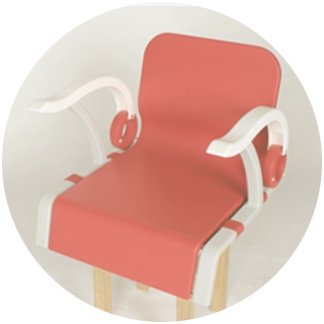 Hyunjoo Bae, a master candidate of CED Lab co-authored an article entitled as “UPO: Chair that lifts your bottom while standing up by using the force pushing down on the armrests” published in Journal of Ergonomics Society of Korea. This paper describes how the UPO chair has developed from the ethnographic user study, mechanical engineering study, and aesthetic development. It was initially a graduation thesis project of Gye-young Kim. Professor Suk was the thesis supervisor and Hyunjoo Bae contributed to document the development process.
Hyunjoo Bae, a master candidate of CED Lab co-authored an article entitled as “UPO: Chair that lifts your bottom while standing up by using the force pushing down on the armrests” published in Journal of Ergonomics Society of Korea. This paper describes how the UPO chair has developed from the ethnographic user study, mechanical engineering study, and aesthetic development. It was initially a graduation thesis project of Gye-young Kim. Professor Suk was the thesis supervisor and Hyunjoo Bae contributed to document the development process.
Abstract
Objective: The objective of the study is to develop a portable assistance device to help elderly users reduce strain on the knee and leg muscle while the elderly are standing up.
Background: The pose of standing up from a chair is a basic movement, but the elderly often have difficulty standing up due to their weak muscles. We focus on designing a solution that helps the elderly reduce physical problems and support them standing up.
Method: This study consists of three parts. Part I explores the way to reduce the refrain of leg muscle while standing up from a chair. In the process of structural development, we found that the moment is minimized when user pushes down the armrests due to a decrease in the force acting on the center of mass. In part II, a user test of 20 participants was carried out to rank the order of comfort of two stimuli: the chair with fixed armrests and the chair with the four-link mechanism that we created-in three different ways; (1) to stand up without touching armrests, (2) to stand up by pushing down on fixed armrests, and (3) to stand up by pushing down on armrests and being supported by the mechanism. To examine the statistically significant differences among the rank means, a Friedman test was conducted. In part Ⅲ, we analyze the results of the user test and interview feedbacks, focusing on establishing a design strategy from UPO and visualizing it in 1:1 scale.
Results: In part I, we decided to develop the four-link mechanism. The bottom is lifted up as the link rises. In part II, based on the rank data, we empirically found that UPO was assessed as the most comfortable during the stimuli. The thigh angle is smaller and the bottom of UPO is separated from a seat. In part III, after assessing the results and feedbacks, we created a visualization strategy for UPO: light, friendly, and novel.
Conclusion: The portable and non-mechanical UPO comprises a four-link system that lifts the user’s hips while standing. It can help users avoid knee and leg muscle strain. Its universal design considers the elderly’s difficulties.
Application: In a future study, combining light and durable material in UPO is expected to increase its usability. And this study is an opportunity to design various types of standing assistance devices.